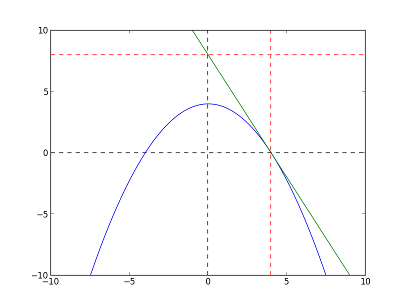-
Posts
578 -
Joined
-
Last visited
Content Type
Profiles
Forums
Events
Posts posted by moth
-
-
Is it a quadratic Bezier curve?
1 -
2013 Si eats a turd
2014 his brother Phil becomes the new Sarah Palin
If you haven't been exposed to Duck Dynasty, that makes no sense, but at least you haven't been exposed to duck dynasty.0 -
Human endorphins harvested during sexual activity affect the aliens the same way mushrooms affect humans.
The extra-terrestrial demand for naturally produced psychotropics is enormous. I saw a piece of it on Liquid Sky.0 -
Is the creationist view that complexity only arises by deliberate action? How can they account for the complexity of a creator.
I find it hard to understand why a complex universe needs a creator but a creator which must have equal or greater complexity than the universe can pop into existance from nothing.0 -
//I can get pretty close with linear approximation, but I don't know how to say it in Math.
#include "stdio.h"
//f(x) = f(a) + f'(a)(x - a)
int main(int argc, char *argv[])
{
float X = -2; //startpoint a=(-2,0)
float slope = -2; //f'(a)
float Y =0; //f(a)
float dx=0.01; //interval
printf("%f\n",Y);
for(X=-2;X<=2;X+=dx){
Y = Y + slope*X*dx;
printf("%f\n",Y);
}
return 0;
}Thanks for another enlightening challenge!
0 -
-
Well, I'm stumped.I was hoping to use the slope of the tangent ( m ) with y = mx + Constant to get the derivative of the parabola at (x,y). Right now I'm trying to get Python to plot it in matplotlib
but mostly just reading the documentation for matplotlib.I'm looking forward to seeing your solution.
0 -
This seems like one I should be able to solve but I'm unsure if the antiderivative will give me the right function to parametrize.
0 -
With apologies to the Who
0 -
I feel old. I thought the way to be a mod was to dress right for a street fight, and go all chains and knives on the greasy rockers.
I think the moderators here do a good job, and just would like to thank them.7 -
What do folks think, is this portrayal of the current situation accurate?
http://www.nytimes.com/2013/10/14/opinion/krugman-the-dixiecrat-solution.html
Even if there are enough "moderate" reverse-dixie republicans willing to allow the country to pay it's bills, John Boehner told George Stephanopoulis he felt Obamacare was so dangerous that he'd rather shut down the government than take the chance people may like it. The metaphore that occurs to me is shooting somebody to prevent their attempt at suicide. But only if you buy the argument that A.C.A. is bad for the country.We've been trying trickle-drown reagonomics for 30 years now, can't we try affordable healthcare for a year or two?2 -
Surprising!

The opening speech left me with the general feeling I get about the tea party: what exactly are they protesting?
Regarding the gun rights activists, I am left to wonder why this guy feels his gun rights are threatened when the current government has done nothing of the sort.
Should I be surprised no one is protesting against the government asking us to quarter soldiers?
I apologize for my previous contribution to this thread. I wasn't allowed in english class when I was in high school.
I just couldn't let this pass unnoticed:
0 -
If you "prove" your god of choice to be real, aren't you really asking people to give up their faith in god, and base their faith on your method?
0 -
Thanks Klaynos. Transformation optics googled up some interesting looking stuff on arxiv.
0 -
Is it possible to model refraction using General Relativity ?
If you assume local speed of light inside a low refractive index material to be c, and find the length contraction and time dilation for an "outside observer",could you work out the local curvature?0 -
The answer to the conjecture is beyond me, so if one of us solves it that would probably be you or md.
I was looking at how long the even-odd-even-odd pattern needed for fastest growth of n could be sustained, and if some property of multiples of two, when constrained by the 3n+1 rule, might interfere.
+1 for the question and 1 for your exposition of your analysis.0 -
Thanks Daedalus, I'm glad I may be not too far off the track.
The output from the first post was showing how long the longest hailstone sequence is for the starting values between 1 and 10, 1 and 100, etc.
The output shows (IF i didn't pooch it) that the longest hailstone sequence found for initial values less than 10000000 is 686 iterations long (for the number 8400511 not shown)0 -
The comments in the code are not correct(apologies). I started this and then houseguests showed up...
This is the first 10 lists. they seem ok
#!/bin/usr/python
MAXARG = 10
## itlist: return a list of iterated values for the argument
def itlist(val):
tlist = []
n=val
while n > 1:
tlist.append(n)
if n & 1:
n = (3 * n) + 1
else:
n = n/2
tlist.append(n)
return tlist
##========================================
## Find the length of the iterated values lists for 1 through MAXARG
countList = [] ## list to hold list length for iterated values from seed
listLen = 0 ## number of iterated values on list
seed = 1 ## seed value to generate list
pow = 10 ## threshold value to check length
max = 0
while seed <= MAXARG:
iterVals = itlist(seed)
listLen = len(iterVals)
print iterVals
countList.append(listLen)
if listLen > max: max = listLen
if seed == pow:
## print pow,max
pow = pow * 10
seed = seed + 1
OUTPUT:
[1]
[2, 1]
[3, 10, 5, 16, 8, 4, 2, 1]
[4, 2, 1]
[5, 16, 8, 4, 2, 1]
[6, 3, 10, 5, 16, 8, 4, 2, 1]
[7, 22, 11, 34, 17, 52, 26, 13, 40, 20, 10, 5, 16, 8, 4, 2, 1]
[8, 4, 2, 1]
[9, 28, 14, 7, 22, 11, 34, 17, 52, 26, 13, 40, 20, 10, 5, 16, 8, 4, 2, 1]
[10, 5, 16, 8, 4, 2, 1]0 -
## I lack skills to do any kind of formal analysis but it is an iteresting question it seems obvious that every list should end, but I couldn't prove it!
##If I didn't make a mistake, this should calculate the lists for every number 1-MAXARG
##save the length of the list of iterated values in a list of lengths
##print out the length of the longest list encountered at powers of ten (longest list of iterates from interval 1-10,1-100,1-1000 etc.)
##With a little modification, the code will also print the lists of iterated values (print iterVals)
##
MAXARG = 10000000
## itlist: return a list of iterated values for the argument
def itlist(val):
tlist = []
n=val
while n > 1:
tlist.append(n)
if n & 1:
n = (3 * n) + 1
else:
n = n/2
tlist.append(n)
return tlist
##========================================
## Find the length of the iterated values lists for 1 through MAXARG
countList = [] ## list to hold iterated values from seed
listLen = 0 ## number of iterated values on list
seed = 1 ## seed value to generate list
pow = 10 ## threshold value to check length
max = 0
while seed <= MAXARG:
iterVals = itlist(seed)
listLen = len(iterVals)
countList.append(listLen)
if listLen > max: max = listLen
if seed == pow:
print pow,max
pow = pow * 10
seed = seed + 1output:
10 20
100 119
1000 179
10000 262
100000 351
1000000 525
10000000 6860 -
I don't know the scale, but the bomb is on a tower, and the "legs" are the guy wires for the tower vaporizing.There was more info in the links at the end of the io9 article, but some of them seem broken now.
0 -
Where's that lifeguard?...I keep wandering in over my head.
If your model is wrong, and not just strange to me, i don't know enough to say which.
What can proper time tell us about photons if it's zero for every photon.
It feels like an "external attribute" like a name, and not something "internal" like polarity or frequency.0 -
So is the proper time for a photon's journey from sun to earth about 8 minutes or zero ?
It seems to me, if you allow c in the domain for calculating the spacetime interval, you get a verticle line on the graph and ds^2 is no longer a proper function.0 -
This is where i get (even more) confused.
Are you saying a photon exists from source to destination at one instant in time and the apparent motion is an illusion?
It seems like the peak we are "riding along with" is not moving or changing it's just there one instant and gone the next.
Can change occur without time passing?Edit: Maybe change can happen in zoro time
0 -
I apologize for my misunderstanding. When swansont asked Widdekind how he calculated proper time (for a photon) you posted an equation that doesn't seem to apply to the situation being discussed. Thanks for clearing that up for me.
0




The Perspective of Motion Through Space
in Relativity
Posted
To predict a geodesic path in GR, is it enough to use the lagrangian idea of action (kinetic energy - potential energy) when it's minimized?